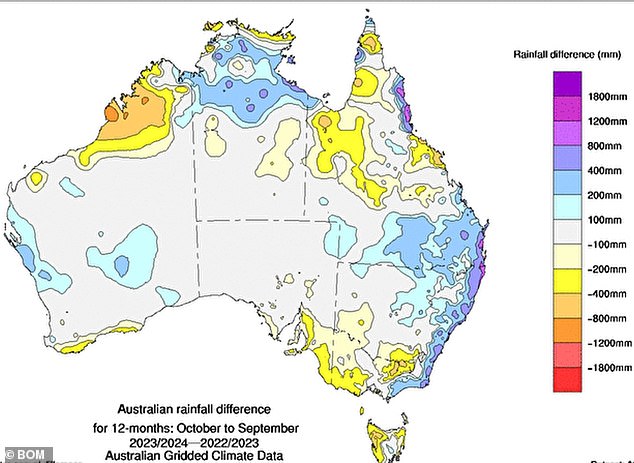Forecasters have warned there is a strong chance La Nina will form before the summer and bring heavy rain and flooding to eastern Australia.
Weatherzone’s Joel Pippard said a “clear La Nina signal” was emerging in the central Pacific Ocean in the form of a pool of cold water pooling about 150 meters below the surface.
“This is often the first sign that La Niña could develop in a given year, and this year was no exception,” he said.
Mr. Pippard explained that La Niña is the cold phase of the El Niño Southern Oscillation (ENSO), which occurs when colder-than-normal waters push westward along the equatorial Pacific Ocean.
“This oceanic pattern, together with changes in the overlying atmosphere, causes warmer water and more rising air to occur over northern Australia, typically increasing spring and early summer rainfall.”
Australia has been in the El Niño phase of the weather pattern for the past 12 months, but was in La Niña between late 2020 and 2022, contributing to the heavy rains that drenched the east coast in those years.
The Bureau of Meteorology has had a ‘La Niña watch’ since May, meaning it estimates there is a 50 per cent chance of the pattern developing, while the normal chance would be about half that.
In September, the World Meteorological Organization said there was a 60 percent chance of La Niña conditions emerging by the end of the year.
Forecasters warn there is a strong chance the La Niña weather pattern will form before summer, bringing heavy rain and flooding to eastern Australia.

Forecasters predict Australia will experience a wet summer. This map shows that there has already been significantly more precipitation on the East Coast this year compared to last year.
In the United States, the National Oceanic and Atmospheric Administration puts the probability at 71 percent, but the US criteria are less strict than those of the BoM.
The Bureau could upgrade its watch to a ‘La Niña alert’, which would have a 70 percent chance, if more signs emerge in the coming weeks, including stronger-than-average trade winds and new cooling trends observed in the Pacific.
Other experts also warn of a wet summer.
Sky News Weather meteorologist Alison Osbourne said the country has been under a “La Nina watch” but the pattern appears to be forming.
“The reason we’ve been in that holding pattern for the last few months is because so far we haven’t seen any strong shift toward a greater likelihood of this phenomenon triggering,” Ms. Osbourne said.
“At the moment we at Sky News Weather are predicting it looks more likely than a 50 per cent chance, but it is developing much later than usual.”
Pippard said colder water in the central Pacific combined with warmer waters around Australia indicated increased rainfall.
‘For almost the entire year, a pool of very cold water has been about 150 meters below the surface in the middle of the Pacific Ocean.
“A tongue of this cold water also extends eastward to near South America, where it is much closer to the surface, but has not completely reached the surface.

Australia has been in the El Niño phase of the weather pattern for the past 12 months, but was in La Niña between late 2020 and 2022, contributing to the heavy rains that drenched the east coast in those years.
“Normally, this cold water would have already triggered a La Niña event, but temperamental weather in the region has continually disrupted this latest step from occurring so far.”
Pippard said at this stage it looks “balanced” as to whether La Nina could form or not, but Australia is in for a wet summer either way.
“Regardless of the statement, climate forecasts for the coming months continue to favor wetter than average conditions in northern and eastern Australia due to the warm waters surrounding Australia.”

